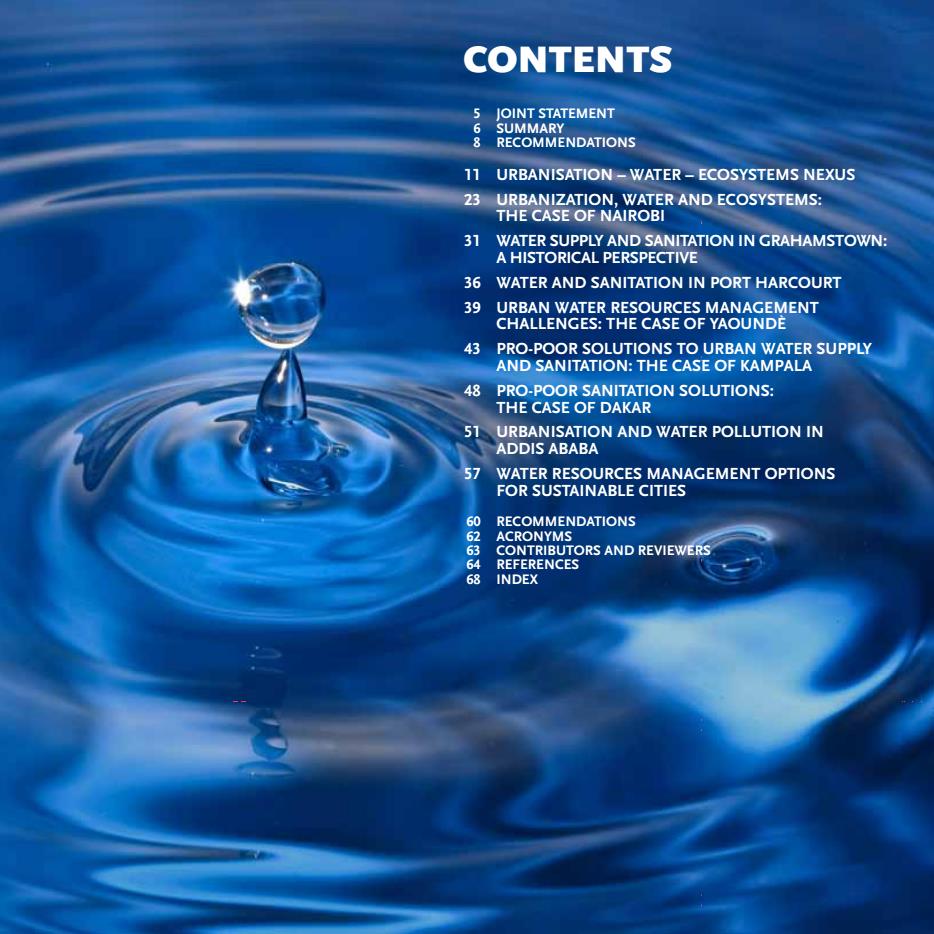
CONTENTS 5 JOINT STATEMENT 11 URBANISATION-WATER-ECOSYSTEMS NEXUS 23 URBANIZATION,WATER AND ECOSYSTEMS: THE CASE OF NAIROBI 31 WATER SUPPLY AND SANITATION IN GRAHAMSTOWN: A HISTORICAL PERSPECTIVE 36 WATER AND SANITATION IN PORT HARCOURT CHALLENCES THECASEDFYAOUNDEENT 48 PRO-POOR SANITATION SOLUTIONS: THE CASE OF DAKAR 51 URBANISATION AND WATER POLLUTION IN ADDIS ABABA 57 WATER RESOURCES MANAGEMENT OPTIONS FOR SUSTAINABLE CITIES RECOMMENDATIONS ACRONYMS 、RE爬EOR5 s AND REVIEWER:
9 JOINT STATEMENT SUMMARY RECOMMENDATIONS URBANISATION – WATER – ECOSYSTEMS NEXUS URBANIZATION, WATER AND ECOSYSTEMS: THE CASE OF NAIROBI WATER SUPPLY AND SANITATION IN GRAHAMSTOWN: A HISTORICAL PERSPECTIVE WATER AND SANITATION IN PORT HARCOURT URBAN WATER RESOURCES MANAGEMENT CHALLENGES: THE CASE OF YAOUNDÈ PRO-POOR SOLUTIONS TO URBAN WATER SUPPLY AND SANITATION: THE CASE OF KAMPALA PRO-POOR SANITATION SOLUTIONS: THE CASE OF DAKAR URBANISATION AND WATER POLLUTION IN ADDIS ABABA WATER RESOURCES MANAGEMENT OPTIONS FOR SUSTAINABLE CITIES RECOMMENDATIONS ACRONYMS CONTRIBUTORS AND REVIEWERS REFERENCES INDEX 5 6 8 11 23 31 36 39 43 48 51 57 60 62 63 64 68 CONTENTS
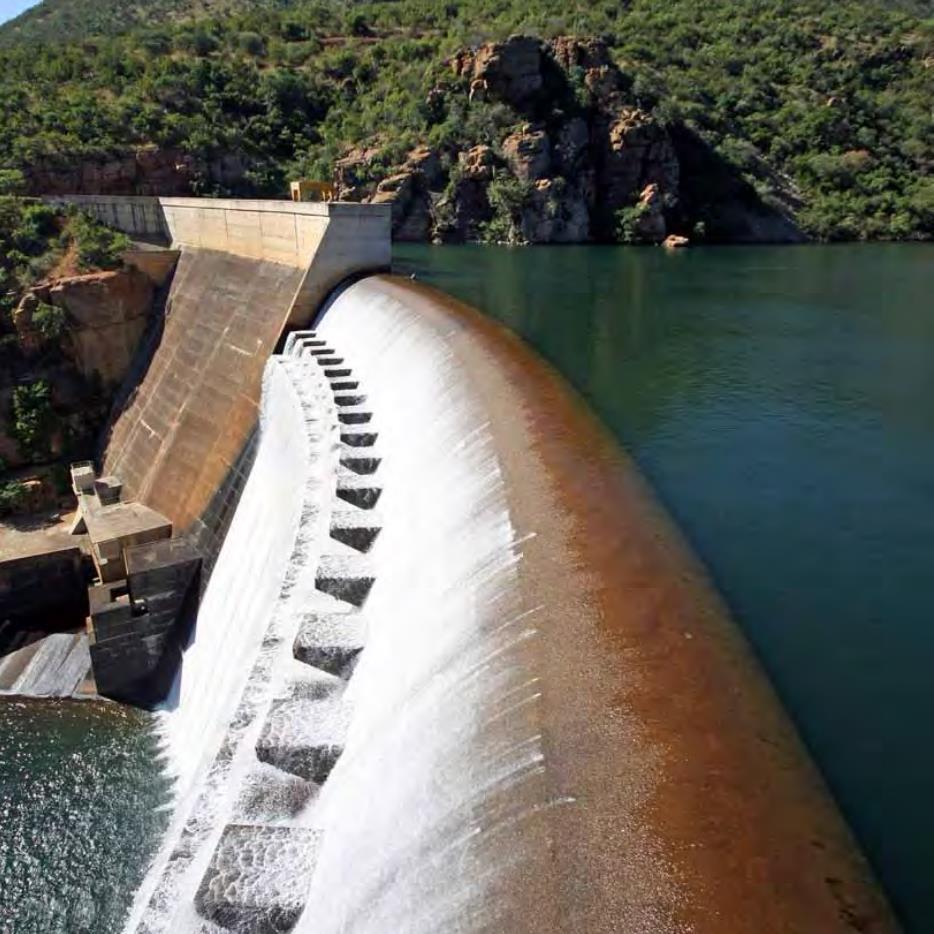
10
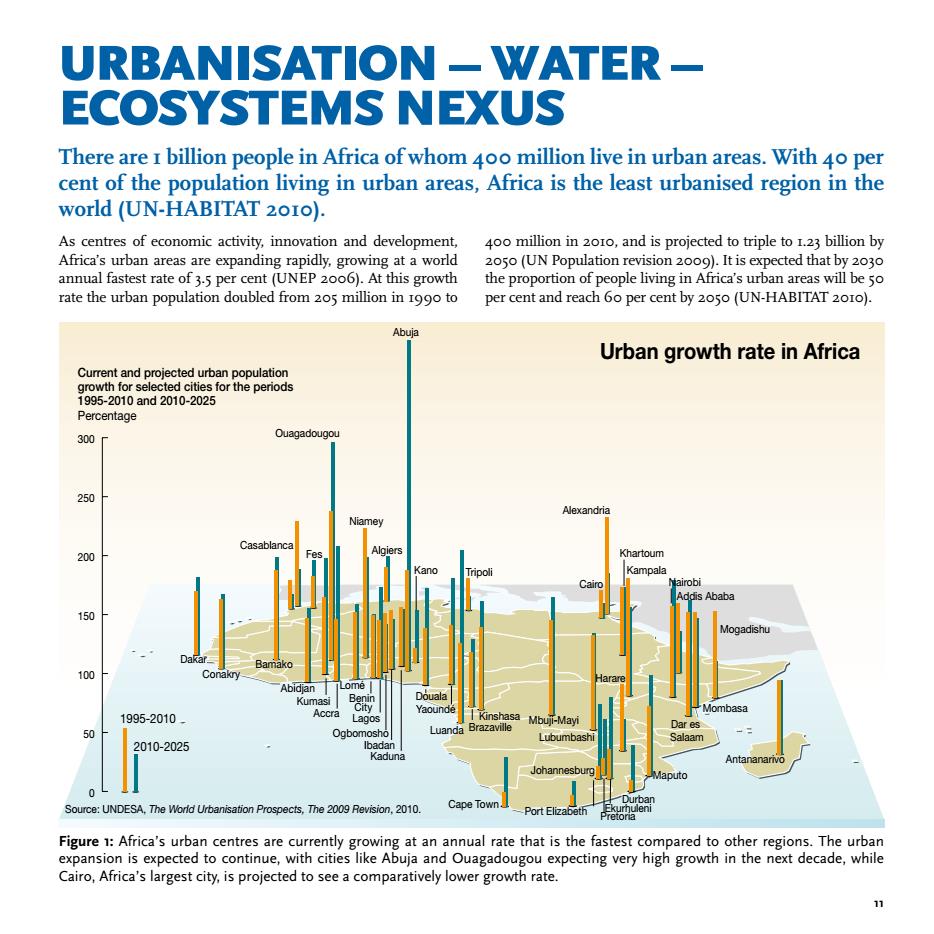
URBANISATION-WATER- ECOSYSTEMS NEXUS There are I billion people in Africa of whom 4oo million live in urban areas.With 4o per cent of the population living in urban areas,Africa is the least urbanised region in the world (UN-HABITAT 2o1o). As centres of economic activity,innovation and development, 400 million in 2o1o,and is projected to triple to 1.23 billion by (UN Population revision)It is expected that by annual fastest rate of 3.5 per cent(UNEP 2006).At this growth the proportion of peopeivng in Afric's un areaswill beo rate the urban population doubled from 2o5 million in 199o to per cent and reach 60 per cent by 2050(UN-HABITAT 2oro). Urban growth rate in Africa 1995-2010and2010-2025 Percentage 00 250 Alexandria Khartoun 1995-2010 50 Oab 010-202 Source:UNDESA.The World Urbanisation Prosoects.The 2009 Revision.2010. Figure 1:Africa'surban centres are currently growing at an annual rate that is the fastest compared toother regions.The urban s expected to continue, with cities like Ab and Ouagadougou expecting very high growth in the next decade,while Crprojcomprve owee 11
11 There are 1 billion people in Africa of whom 400 million live in urban areas. With 40 per cent of the population living in urban areas, Africa is the least urbanised region in the world (UN-HABITAT 2010). As centres of economic activity, innovation and development, Africa’s urban areas are expanding rapidly, growing at a world annual fastest rate of 3.5 per cent (UNEP 2006). At this growth rate the urban population doubled from 205 million in 1990 to Figure 1: Africa’s urban centres are currently growing at an annual rate that is the fastest compared to other regions. The urban expansion is expected to continue, with cities like Abuja and Ouagadougou expecting very high growth in the next decade, while Cairo, Africa’s largest city, is projected to see a comparatively lower growth rate. 400 million in 2010, and is projected to triple to 1.23 billion by 2050 (UN Population revision 2009). It is expected that by 2030 the proportion of people living in Africa’s urban areas will be 50 per cent and reach 60 per cent by 2050 (UN-HABITAT 2010). Source: UNDESA, The World Urbanisation Prospects, The 2009 Revision, 2010. Conakry Lomé Benin City Ibadan Ogbomosho Kaduna Abuja Lagos Dakar Bamako Abidjan Accra Cape Town Ekurhuleni Durban Antananarivo Dar es Salaam Addis Ababa Fes Casablanca Douala Harare Alexandria Kano Tripoli Cairo Ouagadougou Niamey Kumasi Luanda Johannesburg Pretoria Port Elizabeth Maputo Mogadishu Mombasa Nairobi Khartoum Yaoundé Kampala Lubumbashi Kinshasa Brazaville Mbuji-Mayi Algiers 0 50 100 150 200 250 300 Current and projected urban population growth for selected cities for the periods 1995-2010 and 2010-2025 Percentage 1995-2010 2010-2025 Urban growth rate in Africa URBANISATION – WATER – ECOSYSTEMS NEXUS
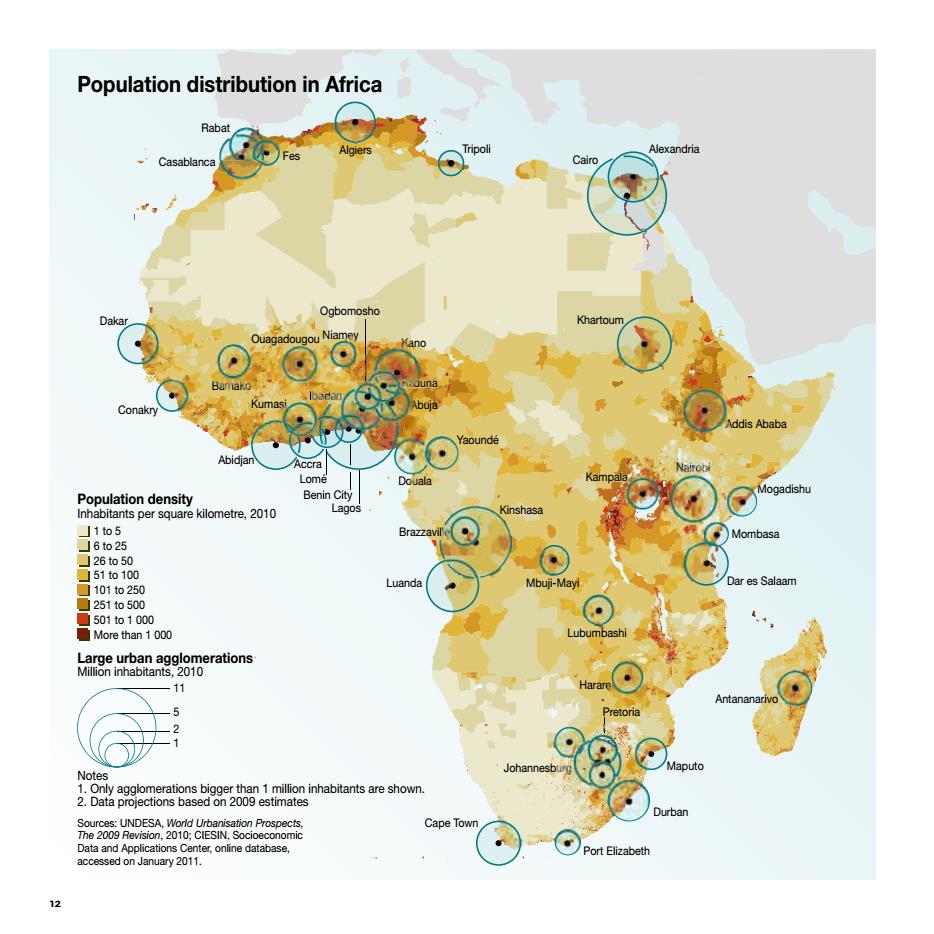
Population distribution in Africa Rabat Casablanca Conakr Abidj Accra Lome Benin City l1t05 6to 25 26t050 51to100 101to250 05 er8e.rbnag928i0erations -11 Johann Notes 2.tominabitants are show. Te2 2010INm Cape Towr Data and nter online database ort Eliza accessed on January 2011
12 Lomé Benin City Ogbomosho Kaduna Abuja Ibadan Lagos Dakar Conakry Bamako Ouagadougou Niamey Kano Abidjan Accra Kumasi Luanda Cape Town Johannesburg Pretoria Port Elizabeth Durban Maputo Antananarivo Mogadishu Mombasa Dar es Salaam Nairobi Addis Ababa Khartoum Algiers Tripoli Fes Casablanca Rabat Yaoundé Douala Kampala Harare Lubumbashi Kinshasa Mbuji-Mayi Brazzaville Alexandria Cairo Million inhabitants, 2010 Inhabitants per square kilometre, 2010 Notes 1. Only agglomerations bigger than 1 million inhabitants are shown. 2. Data projections based on 2009 estimates Sources: UNDESA, World Urbanisation Prospects, The 2009 Revision, 2010; CIESIN, Socioeconomic Data and Applications Center, online database, accessed on January 2011. Large urban agglomerations Population density 11 5 2 1 1 to 5 6 to 25 26 to 50 51 to 100 101 to 250 251 to 500 501 to 1 000 More than 1 000 Population distribution in Africa
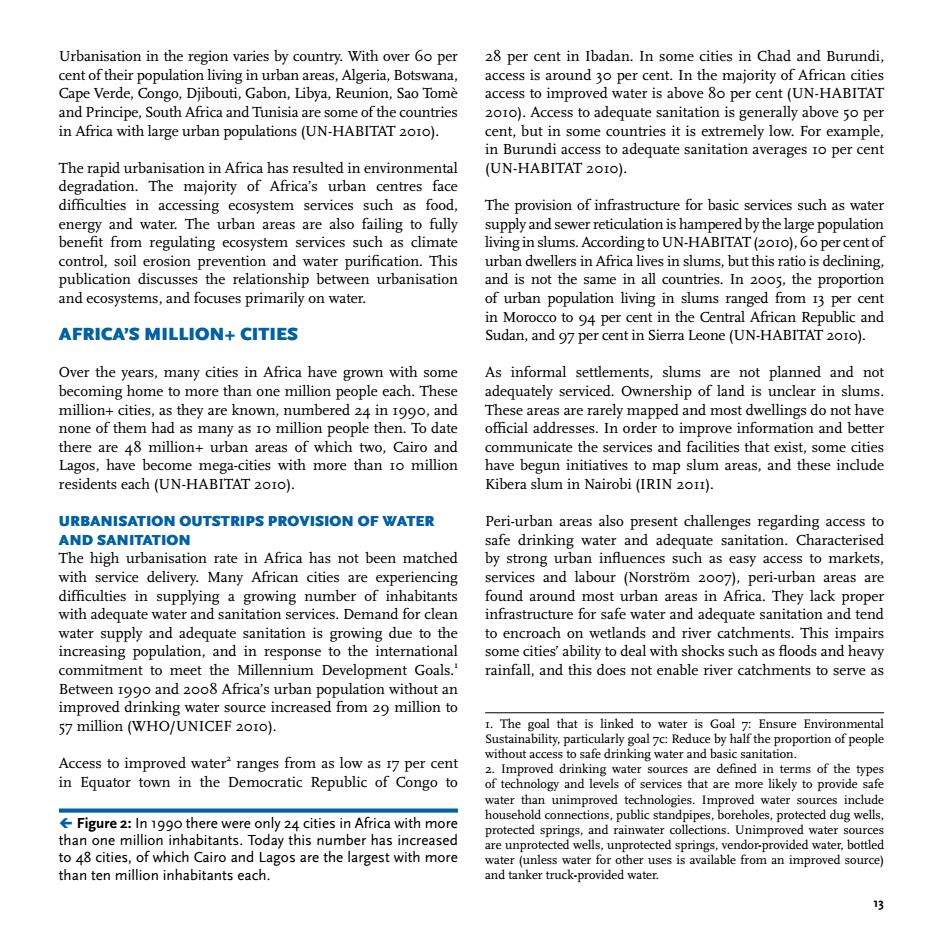
Urbanisation in the region varies by country.With over 6o per 28 per cent in Ibadan.In some cities in Chad and Burundi, cent of their population living n urban areas,Algeria,Botswana access is around 3o per cent.In the majority of African cities Cape Verde,Congo,Djibouti,Gabon,Libya,Reunion,Sao Tome access to improved water is above 8o per cent(UN-HABITAT and Principe,South Africa and Tunisia are some of the countries zoro).Access to adequate sanitation is generally above 5o per in Africa with large urban populations(UN-HABITAT 2oro). cent,but in some countries it is extremely low.For example, in Burundi access to adequate sanitation averages o per cent The rapid urbanisation in Africa has resulted in environmental (UN-HABITAT 20Io). degradation.The majority of Africa's urban centres face difficulties in accessing ecosystem services such as food. The provision of infrastructure for basic services such as water energy and water.The urban areas are also failing to fully supply and sewer reticulation is hampered by the large population benefit from regulating ecosystem services such as climate living in slums.According to UN-HABITAT(20ro),60 er cent of control,soil erosion prevention and water purification.This urban dwellers in Africa lives in slums,but this ratio is declining. publication discusses the relationship between urbanisation and is not the same in all countries.In 2o05,the proportion and ecosystems,and focuses primarily on water. of urban population living in slums ranged from per cent in Morocco to 94 per cent in the Central African Republic and AFRICA'S MILLION+CITIES Sudan,and 97 per cent in Sierra Leone(UN-HABITAT 2oro). Over the years,many cities in Africa have grown with some As informal settlements,slums are not planned and not becoming home to more than one million people each.These adequately serviced.Ownership of land is unclear in slums. million+cities s they are known numberedn 1n none of them had as many peope then. there are 48 million+urban areas of which two,Cairo and communicate the services and facilities that exist,some cities Lagos,have become mega-cities with more than Io million have begun initiatives to map slum areas,and these include residents each(UN-HABITAT) Kibera slum in Nairobi (IRIN). URBANISATION OUTSTRIPS PROVISION OF WATER Peri-urban areas also p resent challenges regarding access to AND SANITATION safe drinking water and adequate saitation.Characterised The high urbanisation rate in Africa has not been matched by strong urban infuences such as easy access to markets with service delivery.Many African cities are experiencing services and labour (Norstrom 2007),peri-urban areas are difficulties in supplying a growing number of inhabitants nd around most urban areas in Africa.They lack prope with adequate water and sanitation services.Demand for clean infrastructure for safe water and adequate sanitation and tend water supply and adequate sanitation isown due to the increasing population,and in response internatio chergach on wetlands and river catchmenls.This impairs cities ability to deal with shocks such as floods and heavy commitment to meet the Millennium Development Goals. rainfall,and this does not enable river catchments to serve as Between andAfrica's urban population without an improved dr ng water source increased from 29 million to 57 million (WHO/UNICEF 2oro). fe drin and ha ni6Paportionofpeopl Access to improved water?ranges from as low as 17 per cent in Equator town in the Democratic Republic of Congo to water than unimproved technologies.Improved water sources include Figure 2:In 199o there were only 24 cities in Africa with more household connections,public standpipes,boreholes,protected dug wells. than one million inhabitants.Today this number has increased protected springs,and rainwater collections.Unimproved water sources to 48 cities,of which Cairo and Lagos are the largest with more arrneoiectedatelsoraroectepngibentiorpronidedaehotled than ten million inhabitants each. ankartnuckprovideadherlsesisawa ss water e from an improved source)
13 Urbanisation in the region varies by country. With over 60 per cent of their population living in urban areas, Algeria, Botswana, Cape Verde, Congo, Djibouti, Gabon, Libya, Reunion, Sao Tomè and Principe, South Africa and Tunisia are some of the countries in Africa with large urban populations (UN-HABITAT 2010). The rapid urbanisation in Africa has resulted in environmental degradation. The majority of Africa’s urban centres face difficulties in accessing ecosystem services such as food, energy and water. The urban areas are also failing to fully benefit from regulating ecosystem services such as climate control, soil erosion prevention and water purification. This publication discusses the relationship between urbanisation and ecosystems, and focuses primarily on water. AFRICA’S MILLION+ CITIES Over the years, many cities in Africa have grown with some becoming home to more than one million people each. These million+ cities, as they are known, numbered 24 in 1990, and none of them had as many as 10 million people then. To date there are 48 million+ urban areas of which two, Cairo and Lagos, have become mega-cities with more than 10 million residents each (UN-HABITAT 2010). URBANISATION OUTSTRIPS PROVISION OF WATER AND SANITATION The high urbanisation rate in Africa has not been matched with service delivery. Many African cities are experiencing difficulties in supplying a growing number of inhabitants with adequate water and sanitation services. Demand for clean water supply and adequate sanitation is growing due to the increasing population, and in response to the international commitment to meet the Millennium Development Goals.1 Between 1990 and 2008 Africa’s urban population without an improved drinking water source increased from 29 million to 57 million (WHO/UNICEF 2010). Access to improved water2 ranges from as low as 17 per cent in Equator town in the Democratic Republic of Congo to 28 per cent in Ibadan. In some cities in Chad and Burundi, access is around 30 per cent. In the majority of African cities access to improved water is above 80 per cent (UN-HABITAT 2010). Access to adequate sanitation is generally above 50 per cent, but in some countries it is extremely low. For example, in Burundi access to adequate sanitation averages 10 per cent (UN-HABITAT 2010). The provision of infrastructure for basic services such as water supply and sewer reticulation is hampered by the large population living in slums. According to UN-HABITAT (2010), 60 per cent of urban dwellers in Africa lives in slums, but this ratio is declining, and is not the same in all countries. In 2005, the proportion of urban population living in slums ranged from 13 per cent in Morocco to 94 per cent in the Central African Republic and Sudan, and 97 per cent in Sierra Leone (UN-HABITAT 2010). As informal settlements, slums are not planned and not adequately serviced. Ownership of land is unclear in slums. These areas are rarely mapped and most dwellings do not have official addresses. In order to improve information and better communicate the services and facilities that exist, some cities have begun initiatives to map slum areas, and these include Kibera slum in Nairobi (IRIN 2011). Peri-urban areas also present challenges regarding access to safe drinking water and adequate sanitation. Characterised by strong urban influences such as easy access to markets, services and labour (Norström 2007), peri-urban areas are found around most urban areas in Africa. They lack proper infrastructure for safe water and adequate sanitation and tend to encroach on wetlands and river catchments. This impairs some cities’ ability to deal with shocks such as floods and heavy rainfall, and this does not enable river catchments to serve as Figure 2: In 1990 there were only 24 cities in Africa with more than one million inhabitants. Today this number has increased to 48 cities, of which Cairo and Lagos are the largest with more than ten million inhabitants each. 1. The goal that is linked to water is Goal 7: Ensure Environmental Sustainability, particularly goal 7c: Reduce by half the proportion of people without access to safe drinking water and basic sanitation. 2. Improved drinking water sources are defined in terms of the types of technology and levels of services that are more likely to provide safe water than unimproved technologies. Improved water sources include household connections, public standpipes, boreholes, protected dug wells, protected springs, and rainwater collections. Unimproved water sources are unprotected wells, unprotected springs, vendor-provided water, bottled water (unless water for other uses is available from an improved source) and tanker truck-provided water